Today I digress from birds or even mammals. Our subject will have no feathers or fur – instead we’ll see paired wings, body segments, antennae and an incredibly long “tongue”. And we’ll have close-up looks at a fascinating insect in flight.
Yesterday morning while I was photographing hummingbirds on Antelope Island I had some opportunities with a sphinx moth. These relatively large moths are also called “hummingbird moths” because at first glance they are often mistaken for hummingbirds as they hover over flowers and use their very long proboscis (“tongue”) to suck up flower nectar while their wings are beating very rapidly.
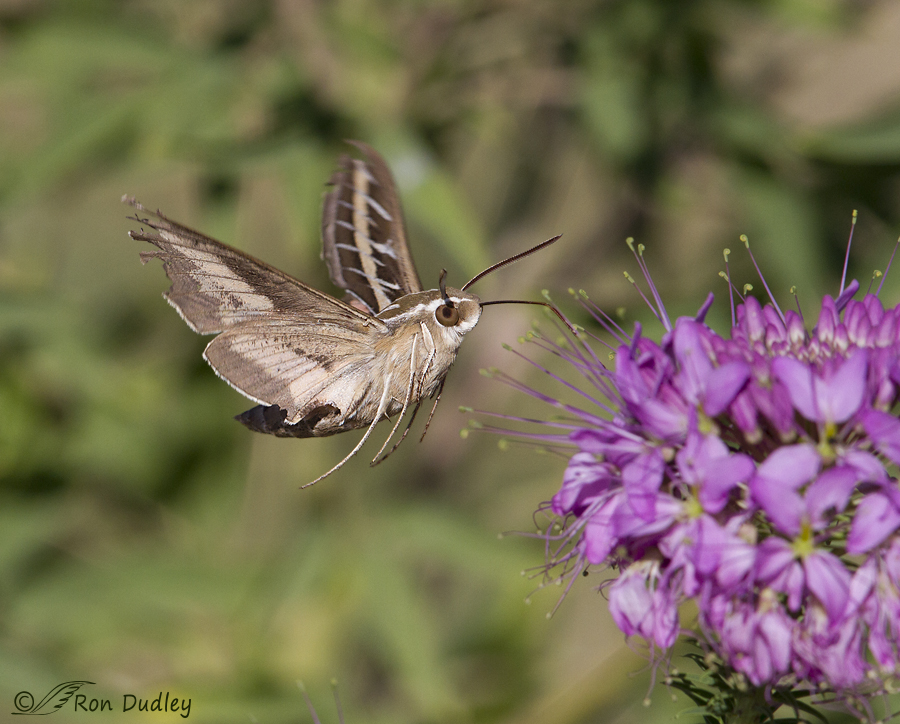
1/4000, f/7.1, ISO 640, Canon 7D, Canon EF500mm f/4L IS II USM +1.4 tc
Like the hummingbirds I was photographing, this moth was feeding on Rocky Mountain Bee Plant. Here the length of its proboscis cannot be appreciated because most of it is hidden behind the filament of a flower stamen (the proboscis can be better seen in later images). As in other insects it has compound eyes but I’m struck by how much they resemble those of a vertebrate.
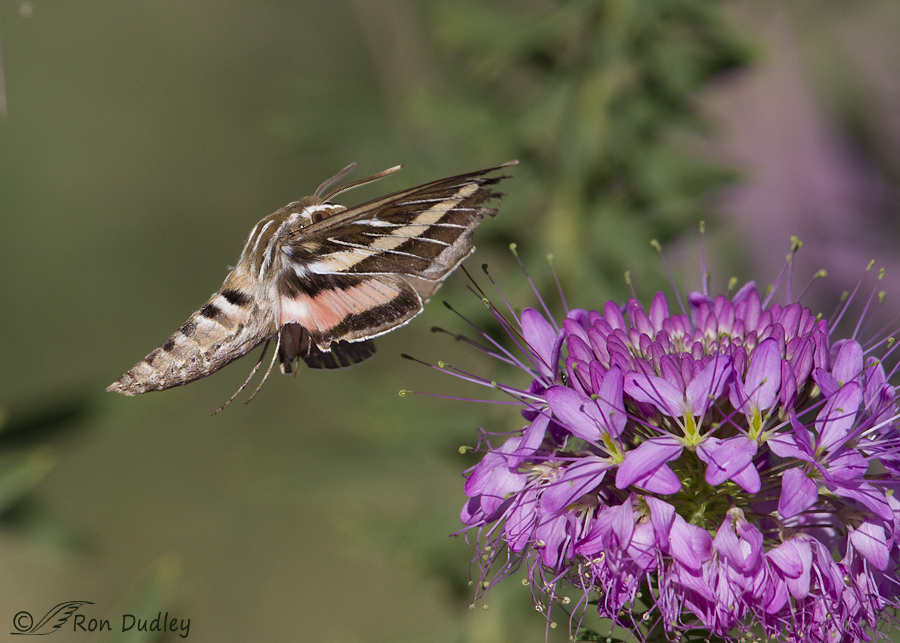
1/4000, f/7.1, ISO 640, Canon 7D, Canon EF500mm f/4L IS II USM +1.4 tc
There are many species of sphinx moths but I believe this one to be the White-lined sphinx (Hyles lineata). I’ve included this image to show the broad pink median band on the hind-wing of this species and also to demonstrate their hummingbird-like hovering flight by the forward-swept wing position. I’m guessing that the speed of their wing-beats is very close to that of hummingbirds because it required similar shutter speeds to freeze the motion.
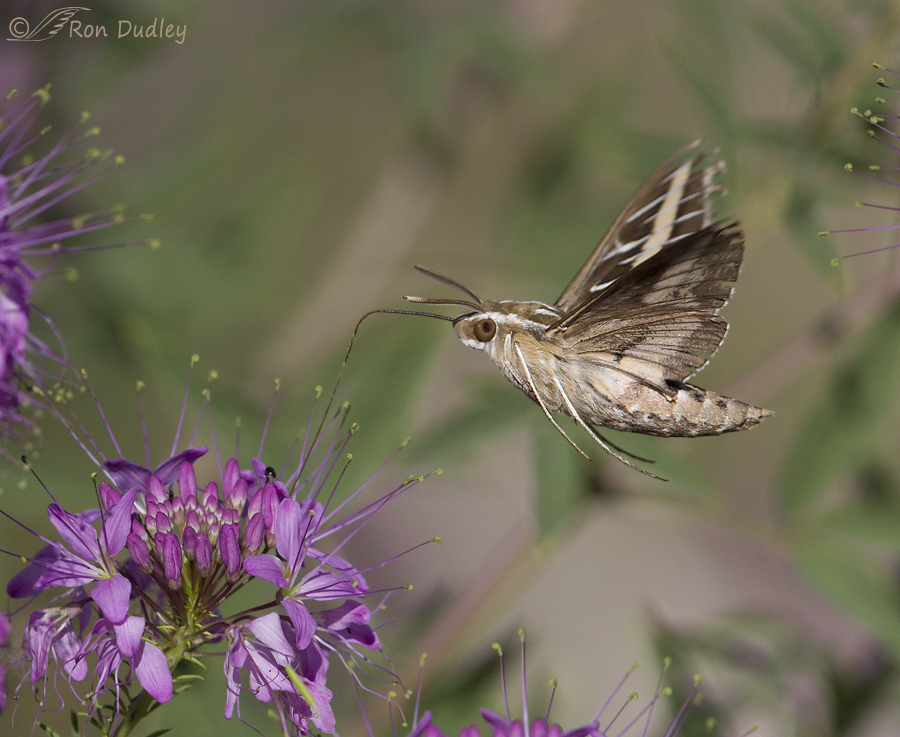
1/4000, f/7.1, ISO 640, Canon 7D, Canon EF500mm f/4L IS II USM +1.4 tc
Here you can see most (though not all) of the length of the pollen-covered proboscis. When not in use the proboscis is kept coiled up beneath the “chin”.
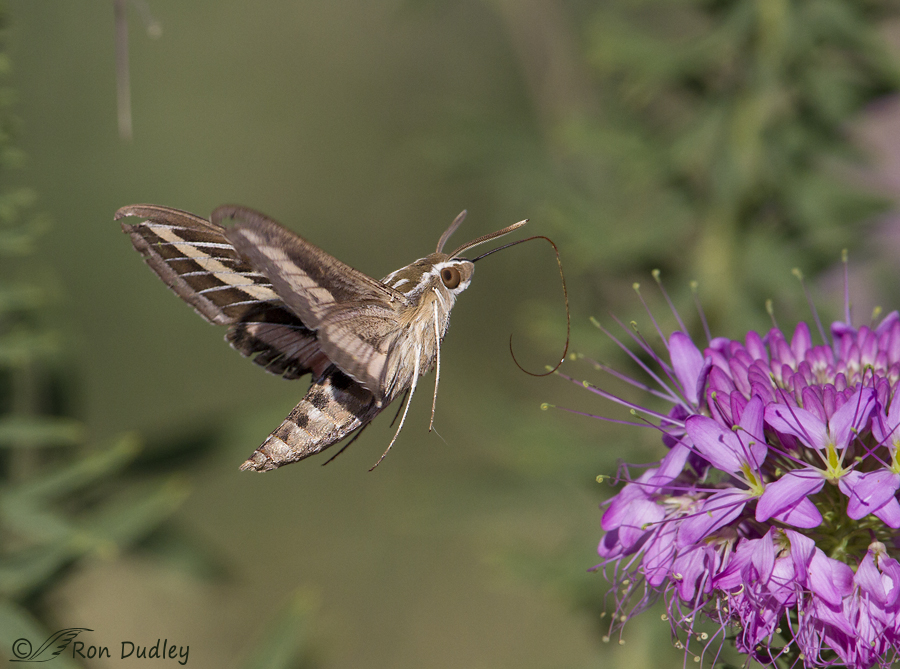
1/4000, f/7.1, ISO 640, Canon 7D, Canon EF500mm f/4L IS II USM +1.4 tc
I snapped this photo just as the moth was uncoiling its proboscis to feed on the flower cluster at right.
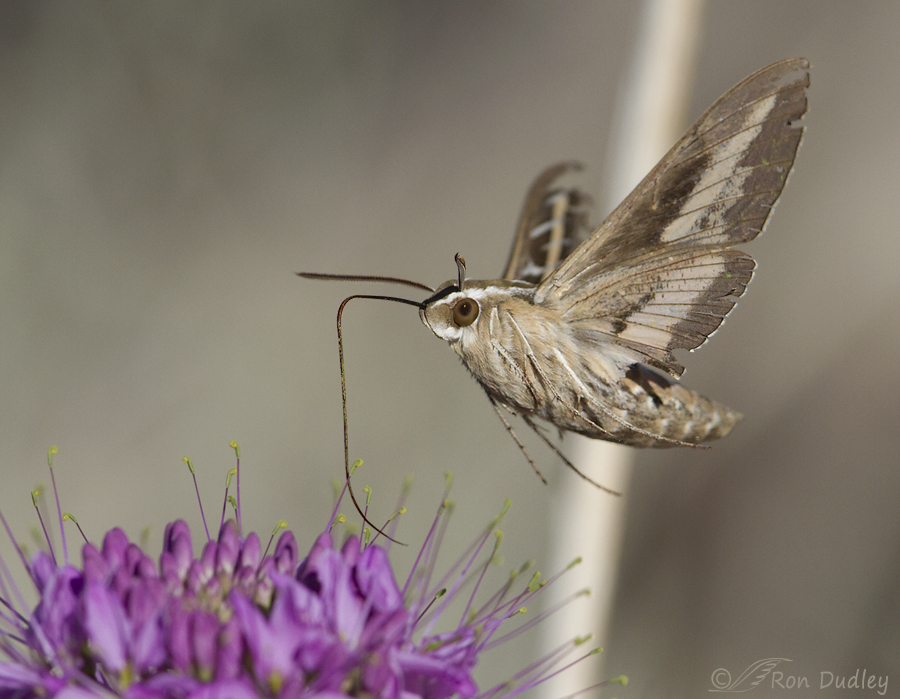
1/5000, f/7.1, ISO 640, Canon 7D, Canon EF500mm f/4L IS II USM +1.4 tc
Though I was disappointed by the bright stem behind the moth I include this shot partly because it shows the groove at the front of the face that accommodates the base of the proboscis while it’s stored in the coiled position.
I really enjoy the close-up looks my lens occasionally gives me of some of the finer details of nature that I normally would never notice or appreciate. While I often photograph birds in flight this was one of my first serious attempts at photographing an insect on the wing. I don’t think it will be my last.
Ron


Beautiful and so fascinating!
Nice shots. I have never seen one so this was very interesting.
I look forward to your pictures every day now.
THANKS!
Fantastic series. Wonderful detail. I’ve had one opportunity to photography these Moths or a very similar species. I need to check and see if it is the same and read some of your references to learn more about them.
Well, I’m happy with feathers and fur,setae,…whatever. For others who’d like to see more,I suggest this site http://www.bugaddiction.com/
Thank you for your images and the interesting comments.
Ron, I could even see the pollen on the proboscis.. Of course not without you telling me what it was. What an amazing series of photos. Thanks very much.
I found my own answer…they are setae, modified scales, bristle like strucures, that protect the body of the moth. They are also found on earthworms and on the toes of geckos
Exactly, Patty. You can actually feel the setae on the underside of an earthworm by rubbing your finger from posterior to anterior (there’s two rows of them). The other direction (anterior to posterior) doesn’t work because they’re very short and they point slightly backward – their purpose is to allow the worm to get a “grip” on the soil and push forward. Not easy to do when you’re creating the burrow in front of you as you go…
I din’t expect insects to have “fur”, but the bodies of the ones we have here look furry. What is it?
Like Mikal, I noticed the missing pieces and yattered edges of that moth’s wings, wondered how tyey got tyat way and how long they lived…I’m feeling a bit tattered and worn myself so empathized.
I’m also amazed to see the splits, holes, and missing bits from the wings. How tattered it is, without seeming to compromise its ability to get on with life. Life is hard! How lucky that we can be good enough without being perfect.
I’ve occasionally had moths like this in my garden and the first time I saw one, I was quite startled. They are so interesting. These shots are great.
I only learnt about the Sphinx moth very recently – and loved increasing my scanty knowledge (and very far from scanty appreciation) with this series. Thank you.
Amazing how they can move those wings that fast! Great “catch” Ron!
outstanding!!! bravo!!!
I can only echo everyone’s comments, especially Dick’s. I have never seen a clear-winged Sphinx moth, but we have plenty of the other kind. I enjoy watching them almost as much as the hummers. They were especially attracted to our Butterfly Bushes, but this past winter killed them. They’re also attracted to our Echinacea, Monarda and Phlox. I love the details shown by your series…they move so fast, I’d never seen most of them. Someone told me they were related to the tomato hornworm…True?
Patty, they’re different species but I believe they’re closely related because the larvae of both species are “hornworms”. Thank you.
Patty, they are definitely related to the tomato hornworm. I’m really surprised that you don’t have the clear-winged hummingbird moths, living in the east. Where I first met them was in Richmond, VA – admittedly farther south, but as best I can tell from my general insects book, their range includes your area. They sound just like the ruby-throated hummingbirds when they go past you. Hopefully you’ll eventually see one (or more)… Susan
I have to chime in here. I have both pictures of the Hummingbird Clearwing Moth and the Snowberry Clearwing Moth here in Vermont. Easy to tell them apart. The Hummingbird Clearwing has chestnut color in the tail and light colored legs, whereas the Snowberry Clearwing has a black tail and black legs. I’d be happy to send someone a picture of each if you so desire, just send a note to me e-mail, raharlow@comcast.net and I’ll send it to you. Please understand they do not even come close to Ron’s pictures, but they do show the differences.
Sensational series Ron! I also learned something. I thought this little one was referred to as a white lined spynx, I thought the clear wing was referred to as the humming bird moth. Now I find that both are. Thanks for sharing your sensational shots!
Charlotte
I’m glad we could help clear up some of the confusion, Charlotte. Thank you.
Fantastic series of images Ron, you made my day today. Thank for sharing this amazing series of image.
Thanks very much, Butch.
I look forward to your photos every day. The moth photos are beyond amazing. Thank you for sharing such close up views of the wonderful creatures of the natural world. I always feel inspired and awestruck by your photos.
Thanks, Eloise. I’m glad you enjoyed the images.
Everyone already said everything about these shots. Amazing captures. I think there are a couple of species called hummingbird moths. Occasionally a few will visit my yard. I have never seen the tongue before. Thanks Ron. Fascinating.
There apparently are quite a few species referred to as “hummingbird moths”, Ellen. Thank you.
This is indeed a white-lined sphinx. We’ve been seeing a lot of them lately, and I had not previously realized that they were day-fliers. In all the years I’ve been collecting and observing butterflies and moths, I’ve never heard this one referred to as a hummingbird moth, although I can understand why it would be. The ones I know to have that appellation are clear-winged day-flying sphinx moths that are about half the size of the white-lined sphinx. The clear-winged ones are easily mistaken for hummingbirds because of the speed at which they fly and the buzzing sound they make in passing. (I first encountered them when I was living in an area with ruby-throated hummingbirds, which have always sounded rather like buzz saws to me.)
You’ve done a great job of capturing images of a creature I love. Getting all the different wing positions reminds me of your bird photographs, and I really like it that you took the time to photograph this moth in detail.
Thank you very much for the confirmation, Susan – I certainly don’t know insects as well as I do birds. My research indicated that the White-lined sphinx (along with the clear-winged species) is also called “hummingbird moth” – http://en.wikipedia.org/wiki/Hyles_lineata
Cooperative subject or not Ron, you’ve “nailed” it in a way I’ve not been able to either duplicate or have even seen before!
I just have to agree with Dick, because he’s used up all the adjectives, LOL. Oh, a couple more, stupendous, beautiful, stunning color, sharpness and composition!
I appreciate the kind words, Alan. A lot.
WOW!! Those shots are wonderful, marvelous, fantastic, exceptional, running out of adjectives!! You are an exceptional photographer and I much appreciate your art and that you share it! Wonderful composition, sharp as a tack,just terrific!
I try and take shots of insects, close-ups, macro, etc., they don’t even compare.
Thanks very much, Dick. I like these shots too but I owe at least part of their appeal to a cooperative and relatively large (2-3″) subject.